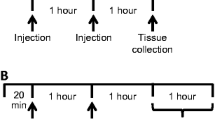Summary
Animals received either haloperidol (2 mg/kg) or probenecid (200 mg/kg) in conjunction with tyrosine (100 mg/kg) or its diluent. Striatal homovanillic acid levels increased in probenecid-treated animals to the same range whether they were given tyrosine or not. In haloperidol-treated animals the levels of homovanillic acid were significantly elevated in animals receiving tyrosine. Tyrosine and homovanillic acid levels were highly correlated as determined by linear regression analysis.
Similar content being viewed by others
References
Coyle, J. T.: Tyrosine hydroxylase in brain-cofactor requirements, regional and subcellular distribution. Biochem. Pharmac.21, 1935–1944 (1972).
Glowinski, J., Iversen, L. L.: Regional studies of catecholamines in the rat brain. I. J. Neurochem.13, 665–669 (1966).
Gudelsky, G. A., Moore, K. E.: Differential drug effects on dopamine concentrations and rates of turnover in the median eminence, olfactory tubercle and corpus striatum. J. Neural Trans.38, 95–105 (1976).
Renaud, B., Quenin, P., Quincy, C.: Détermination fluorimétrique enflux centiner de l'acide homovanillique. Application au liquide céphalorachidien. Clin. Chim. Acta52, 179–185 (1974).
Spector, R., Lorenzo, A. V.: The effects of salicylate and probenecid on the cerebrospinal fluid transport of penicillin, aminosalicyclic acid and iodide. J. Pharmac. Ext. Ther.188, 55–65 (1974).
Ungerstedt, U., Butcher, L. L., Butcher, S. G., Andén, N.-E., Fuxe, K.: Direct chemical stimulation of dopaminergic mechanisms in the neostriatum of the rat. Brain Res.14, 461–471 (1969).
Waalkes, T. P., Udenfriend, S.: A fluorometric method for estimation of tyrosine in plasma and tissues. J. Lab. Clin. Med.50, 733–736 (1957).
Waymire, J. C., Bjun, R., Weiner, N.: Assay of tyrosine hydroxylase by coupled decarboxylation of dopa formed from 1-14C-tyrosine. Analyt. Biochem.43, 588–600 (1971).
Wurtman, R. J., Larin, F., Mostafapour, S., Fernstrom, J. D.: Brain catechol synthesis: Control by brain tyrosine concentration. Science185, 183–184 (1974).
Wurtman, R. J., Fernstrom, J. D.: Control of brain monoamine synthesis by diet and plasma amino acids. Am. J. Clin. Nutr.28, 638–647 (1975).
Zivkovic, B., Guidotti, A., Costa, E.: Effects of neuroleptics on striatal tyrosine hydroxylase changes in affinity for the pteridine cofactor. Molec. Pharmac.10, 727–735 (1974).
Zivkovic, B., Guidotti, A.: Changes of kinetic content of striatal tyrosine hydroxylase elicited by neuroleptics that impair the function of dopamine receptors. Brain Res.79, 505–509 (1974).
Author information
Authors and Affiliations
Rights and permissions
About this article
Cite this article
Scally, M.C., Ulus, I. & Wurtman, R.J. Brain tyrosine level controls striatal dopamine synthesis in haloperidol-treated rats. J. Neural Transmission 41, 1–6 (1977). https://doi.org/10.1007/BF01252960
Received:
Issue Date:
DOI: https://doi.org/10.1007/BF01252960




